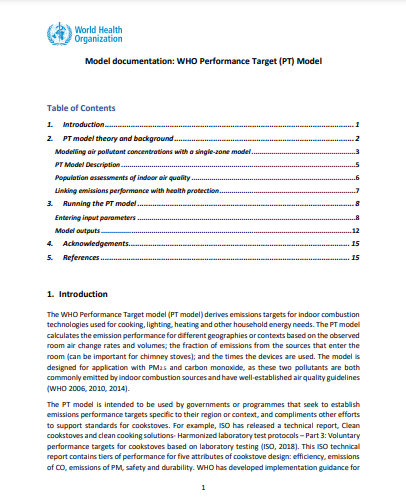Performance Target (PT) model documentation

Overview
The PT model calculates the emission performance for different geographies or contexts based on the observed room air change rates and volumes; the fraction of emissions from the sources that enter the room (can be important for chimney stoves); and the times the devices are used. The model is designed for application with PM2.5 and carbon monoxide, as these two pollutants are both commonly emitted by indoor combustion sources and have well-established air quality guidelines (WHO 2006, 2010, 2014).
The PT model is intended to be used by governments or programmes that seek to establish emissions performance targets specific to their region or context, and compliments other efforts to support standards for cookstoves. For example, ISO has released a technical report, Clean cookstoves and clean cooking solutions- Harmonized laboratory test protocols – Part 3: Voluntary performance targets for cookstoves based on laboratory testing (ISO, 2018). This ISO technical report contains tiers of performance for five attributes of cookstove design: efficiency, emissions of CO, emissions of PM, safety and durability. WHO has developed implementation guidance for 2 the national adoption of voluntary performance targets (VPTs).
The PT model described here is the model that was used to develop the ISO voluntary performance targets. The primary application of the PT model is to derive context-specific targets (or tiers) for PM and CO emissions. The performance targets can be used within a standards framework to guide which technologies are more or less likely to provide health benefits. Specific users of the model are anticipated to be technical groups, such as testing laboratories and organizations, which work with government ministries, standards-setting agencies, and programme implementers to inform their performance targets for cookstoves and clean cooking solutions.
Aside from formal standards-setting activities, the PT model can also be used to explore how changing conditions (e.g. changes in ventilation rates or cooking times) relate to stove emissions performance targets. Importantly, the model is only intended to illustrate the potential impacts from different levels of emissions and is not intended as a replacement for technology or programme evaluation in field settings. This document provides theoretical underpinnings of the model and background for its development and serves as a guide to running the web-based version.
